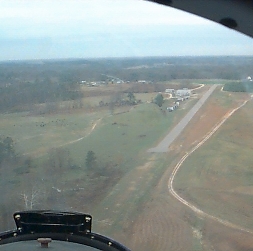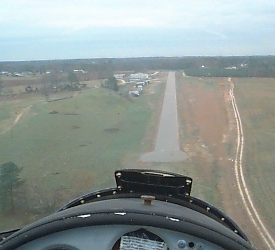Gliding in North Carolina
|
GLIDING IN NORTH CAROLINA |
|
-- Half an hour in a Blanik -- |
In December 1998 I went on an unexpected business trip to Raleigh, NC.
I have a number of friends up in Raleigh, one of whom is a glider pilot.
The opportunity therefore presented itself to find out what soaring was
about - and I got to do it from the front seat of a Blanik two-seat
glider.
On Saturday 12th December, I went with my friend Dave Laitinen to Ball field
(a small private but paved strip in rural North Carolina) to fly the glider.
I was only in North Carolina for a few days, so Saturday was the only chance
we had. As you can see from the photographs, it wasn't a good lift day.
A thin layer of stratus clouds loitered around at about 9,000 feet meaning
we'd just get towed up there...and float back down! We flew for half an
hour in total, which isn't bad considering the lack of lift.
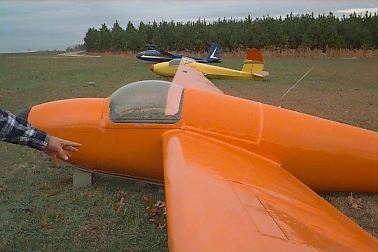 There are a number of gliders based at Ball (as well as many
other interesting aircraft, of which we'll see more of later). The orange
one in the foreground is one of Dave's gliders (he has a half-share in
two single seaters, one of them being a composite high performance
machine). The Blanik we flew is in the background of this picture.
Dave spent some time showing me the various different aircraft on the
field. There's quite a variety of gliders and construction methods: some
are wooden, some are all metal, others fabric, and of course there's the
composite. Most were certificated by the FAA, but some were in the
Experimental category.
There are a number of gliders based at Ball (as well as many
other interesting aircraft, of which we'll see more of later). The orange
one in the foreground is one of Dave's gliders (he has a half-share in
two single seaters, one of them being a composite high performance
machine). The Blanik we flew is in the background of this picture.
Dave spent some time showing me the various different aircraft on the
field. There's quite a variety of gliders and construction methods: some
are wooden, some are all metal, others fabric, and of course there's the
composite. Most were certificated by the FAA, but some were in the
Experimental category.
 The Cirrus here is an experimental. This is Dave's other
glider. He wheeled it off the trailer so I could take a quick look at it.
As is common with most gliders...the panel is pretty sparse. It contains'
the basic VFR instrumentation only with the addition of a vario - basically
a more advanced VSI that shows your energy state by compensating for
'zoom climbs' initiated by just yanking back on the stick. The airfoil
shape on this glider is quite noticable - notice the under camber on
the underside of the wing-root attachment. The wings also have aileron
gap seals, and the finish of the entire aircraft is very smooth. As you
can see, I got to sit in it and try it for size. The pilot's position is
actually pretty comfortable (and it needs to be; glider pilots can spend
hours at a time soaring)
The Cirrus here is an experimental. This is Dave's other
glider. He wheeled it off the trailer so I could take a quick look at it.
As is common with most gliders...the panel is pretty sparse. It contains'
the basic VFR instrumentation only with the addition of a vario - basically
a more advanced VSI that shows your energy state by compensating for
'zoom climbs' initiated by just yanking back on the stick. The airfoil
shape on this glider is quite noticable - notice the under camber on
the underside of the wing-root attachment. The wings also have aileron
gap seals, and the finish of the entire aircraft is very smooth. As you
can see, I got to sit in it and try it for size. The pilot's position is
actually pretty comfortable (and it needs to be; glider pilots can spend
hours at a time soaring)
|
-- Lined up for Takeoff -- |
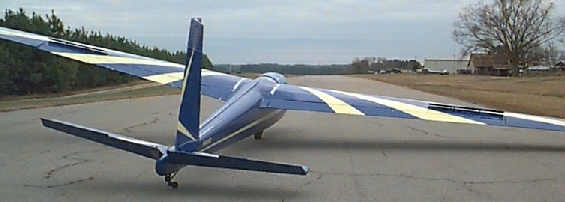
First we let John the tow-pilot know we were about to go, then dragged
the Blanik up to the runway, being careful not to scrape the wingtips
on the runway (the Blanik has a 15 meter wingspan and wheels only on
the centerline of the fuselage, so you need to ensure you support the
wingtip!) You can see that the spoilers on the wing are extended a little.
The towplane duly arrives, and we get the cable hooked up. The towplane
is a straight tailed Cessna 150 with a 150 h.p. engine conversion. (I
got to fly it later as well). Dave's checked out to fly the Blanik
from the back, so I got to sit in the front!
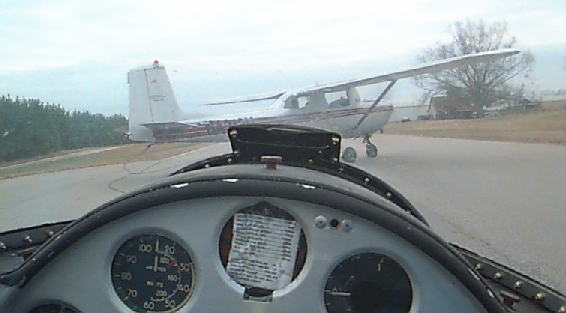
It's interesting being towed by another aircraft. We got
dragged along the runway for a while, and after a short time, the ailerons
became effective and Dave could hold the wingtips up (they actually have
skids on the tips so they can slide along for a while). We were soon
airborne, flying in close formation with the Cessna 150 on the end of
a tow line.
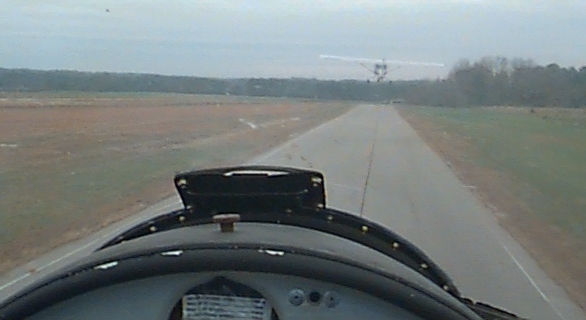
We were towed up to 4,000 feet or thereabouts. I got to take
the stick for a short amount of time on the tow, and for a first-timer,
I didn't do too badly, but I did feel kind of anxious! (I have been both
the towing vehicle and the towee on the road, and I remember what happened
if the line got slack and the slack was suddenly removed!)
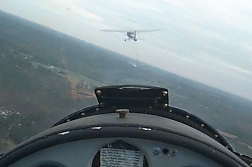 Once released
from the towline, the towplane quickly broke left and headed back to
Ball. We now had just the sound of the wind rushing past the airframe
to keep us company. The nice thing about gliding is that you don't need
a headset - you can carry out a conversation without a problem. You can
also almost gauge your airspeed from the sound of the wind rushing
past the airframe. The cold, still (and totally liftless) air gave
us a smooth ride. Dave turned the controls over to me, and I got a feel
for how it handled. The yaw string was a little confusing at first
(airplanes have a turn coordinator to measure the quality of your turns...
but a glider has a piece of string taped to the canopy!) The yaw string
is extremely sensitive, and it also gives reverse sensing. In an
airplane, you step on the ball. However, if you rudder the same direction
as the yawstring goes, you'll set up a superb slip! Now you haven't seen
adverse yaw until you've tried a glider. I tried moving the stick briskly
left and right without using the rudder. You get quite a lot of adverse
yaw if you do this in a Cessna 150, but in a glider the adverse yaw
is stupendous. On the other hand, the rudder pedals are actually reasonably
sensitive, so the amount of rudder pressure I needed to use on the Blanik
seemed about the same as a Cessna 150. This is the sort of thing that'd
give Piper Cherokee pilots kittens! One thing that was quite interesting
was that the altimeter tends to hang up a little as you descend. In
a piston airplane, there's enough vibration to stop this from happening.
You periodically need to gently tap the altimeter to get it to indicate
the correct altitude. Every so often I'd hear 'taptaptaptaptap' as Dave
tapped his altimeter, so I'd give mine a quick tap, and it'd indicate
the correct altitude.
Once released
from the towline, the towplane quickly broke left and headed back to
Ball. We now had just the sound of the wind rushing past the airframe
to keep us company. The nice thing about gliding is that you don't need
a headset - you can carry out a conversation without a problem. You can
also almost gauge your airspeed from the sound of the wind rushing
past the airframe. The cold, still (and totally liftless) air gave
us a smooth ride. Dave turned the controls over to me, and I got a feel
for how it handled. The yaw string was a little confusing at first
(airplanes have a turn coordinator to measure the quality of your turns...
but a glider has a piece of string taped to the canopy!) The yaw string
is extremely sensitive, and it also gives reverse sensing. In an
airplane, you step on the ball. However, if you rudder the same direction
as the yawstring goes, you'll set up a superb slip! Now you haven't seen
adverse yaw until you've tried a glider. I tried moving the stick briskly
left and right without using the rudder. You get quite a lot of adverse
yaw if you do this in a Cessna 150, but in a glider the adverse yaw
is stupendous. On the other hand, the rudder pedals are actually reasonably
sensitive, so the amount of rudder pressure I needed to use on the Blanik
seemed about the same as a Cessna 150. This is the sort of thing that'd
give Piper Cherokee pilots kittens! One thing that was quite interesting
was that the altimeter tends to hang up a little as you descend. In
a piston airplane, there's enough vibration to stop this from happening.
You periodically need to gently tap the altimeter to get it to indicate
the correct altitude. Every so often I'd hear 'taptaptaptaptap' as Dave
tapped his altimeter, so I'd give mine a quick tap, and it'd indicate
the correct altitude.
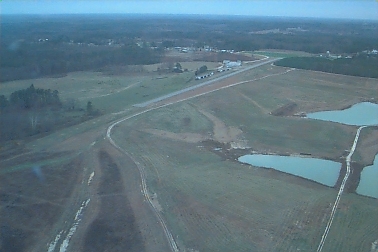 Due to the dismal lack of lift, it wasn't too long before
we had to get back to the airfield. Glider pilots fly a pattern just
like power ones do - here we are on base leg for Ball. (Ball is on
an incline, so you almost always take off downhill and land uphill
unless the wind is really strong.)
Due to the dismal lack of lift, it wasn't too long before
we had to get back to the airfield. Glider pilots fly a pattern just
like power ones do - here we are on base leg for Ball. (Ball is on
an incline, so you almost always take off downhill and land uphill
unless the wind is really strong.)
The next three pictures show how
effective the flaps and spoilers are on the Blanik! It looks like
we are really high turning final, but we easily make the landing
pretty much on the numbers (if Ball actually had numbers, that is!)
Turning final and on short final...
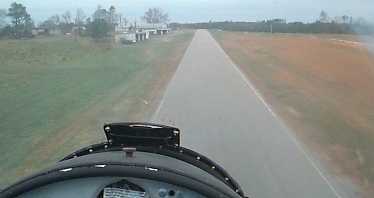
About to touch down at Ball
There's no doubt about it. Flying the glider was fun - it's just
a shame that there was no lift! There is a glider club in Houston, and
I'm certain that I will pursue my glider rating before 1999 is out (and
that'll be another flight journal!)
|
-- Other interesting things at Ball -- |
Ball had a collection of interesting aircraft. In the hangar, someone was
working on recovering a fabric covered wing, and there was a collection
of unusual aircraft (a green Piper Cub for example!) I also got
to fly the towplane, a Cessna 150 with a 150 hp engine. This is how
all Cessna 150's should have been made! It climbs pretty well with this
engine, and John the tow pilot demonstrated how you can practically hang
it off the prop (he slowly pulled the yoke back at full power, and instead
of stalling, the plane sort of mushes along in a gradual climb). The
straight-tailed 150's slip pretty well too, as I discovered. John was
very trusting, since he let me fly from the left seat, takeoff and land
the thing without ever knowing how good of a pilot I was! Landing it
was a little different from a conventional 150 on account of the towhook -
he told me to just flare it nose up, but don't keep pulling back otherwise
the hook will drag on the runway. (You also must never land it flat, since
the prop is a bit longer than on the standard 150 and doesn't have much
ground clearance). Below are some pictures of some of what was at
Ball.
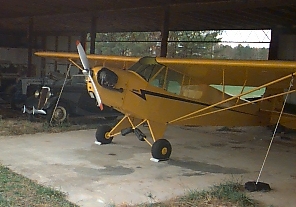
A standard yellow Piper Cub
|
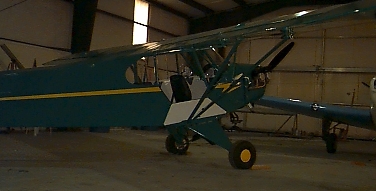
...and how odd, a green Cub!
|
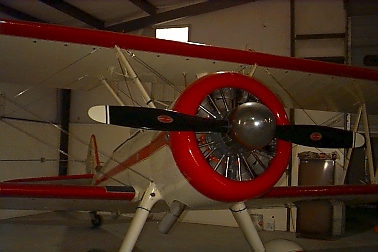
...and a Stearman too.
[Back to Flying]
 There are a number of gliders based at Ball (as well as many
other interesting aircraft, of which we'll see more of later). The orange
one in the foreground is one of Dave's gliders (he has a half-share in
two single seaters, one of them being a composite high performance
machine). The Blanik we flew is in the background of this picture.
Dave spent some time showing me the various different aircraft on the
field. There's quite a variety of gliders and construction methods: some
are wooden, some are all metal, others fabric, and of course there's the
composite. Most were certificated by the FAA, but some were in the
Experimental category.
There are a number of gliders based at Ball (as well as many
other interesting aircraft, of which we'll see more of later). The orange
one in the foreground is one of Dave's gliders (he has a half-share in
two single seaters, one of them being a composite high performance
machine). The Blanik we flew is in the background of this picture.
Dave spent some time showing me the various different aircraft on the
field. There's quite a variety of gliders and construction methods: some
are wooden, some are all metal, others fabric, and of course there's the
composite. Most were certificated by the FAA, but some were in the
Experimental category.
 The Cirrus here is an experimental. This is Dave's other
glider. He wheeled it off the trailer so I could take a quick look at it.
As is common with most gliders...the panel is pretty sparse. It contains'
the basic VFR instrumentation only with the addition of a vario - basically
a more advanced VSI that shows your energy state by compensating for
'zoom climbs' initiated by just yanking back on the stick. The airfoil
shape on this glider is quite noticable - notice the under camber on
the underside of the wing-root attachment. The wings also have aileron
gap seals, and the finish of the entire aircraft is very smooth. As you
can see, I got to sit in it and try it for size. The pilot's position is
actually pretty comfortable (and it needs to be; glider pilots can spend
hours at a time soaring)
The Cirrus here is an experimental. This is Dave's other
glider. He wheeled it off the trailer so I could take a quick look at it.
As is common with most gliders...the panel is pretty sparse. It contains'
the basic VFR instrumentation only with the addition of a vario - basically
a more advanced VSI that shows your energy state by compensating for
'zoom climbs' initiated by just yanking back on the stick. The airfoil
shape on this glider is quite noticable - notice the under camber on
the underside of the wing-root attachment. The wings also have aileron
gap seals, and the finish of the entire aircraft is very smooth. As you
can see, I got to sit in it and try it for size. The pilot's position is
actually pretty comfortable (and it needs to be; glider pilots can spend
hours at a time soaring)



 Once released
from the towline, the towplane quickly broke left and headed back to
Ball. We now had just the sound of the wind rushing past the airframe
to keep us company. The nice thing about gliding is that you don't need
a headset - you can carry out a conversation without a problem. You can
also almost gauge your airspeed from the sound of the wind rushing
past the airframe. The cold, still (and totally liftless) air gave
us a smooth ride. Dave turned the controls over to me, and I got a feel
for how it handled. The yaw string was a little confusing at first
(airplanes have a turn coordinator to measure the quality of your turns...
but a glider has a piece of string taped to the canopy!) The yaw string
is extremely sensitive, and it also gives reverse sensing. In an
airplane, you step on the ball. However, if you rudder the same direction
as the yawstring goes, you'll set up a superb slip! Now you haven't seen
adverse yaw until you've tried a glider. I tried moving the stick briskly
left and right without using the rudder. You get quite a lot of adverse
yaw if you do this in a Cessna 150, but in a glider the adverse yaw
is stupendous. On the other hand, the rudder pedals are actually reasonably
sensitive, so the amount of rudder pressure I needed to use on the Blanik
seemed about the same as a Cessna 150. This is the sort of thing that'd
give Piper Cherokee pilots kittens! One thing that was quite interesting
was that the altimeter tends to hang up a little as you descend. In
a piston airplane, there's enough vibration to stop this from happening.
You periodically need to gently tap the altimeter to get it to indicate
the correct altitude. Every so often I'd hear 'taptaptaptaptap' as Dave
tapped his altimeter, so I'd give mine a quick tap, and it'd indicate
the correct altitude.
Once released
from the towline, the towplane quickly broke left and headed back to
Ball. We now had just the sound of the wind rushing past the airframe
to keep us company. The nice thing about gliding is that you don't need
a headset - you can carry out a conversation without a problem. You can
also almost gauge your airspeed from the sound of the wind rushing
past the airframe. The cold, still (and totally liftless) air gave
us a smooth ride. Dave turned the controls over to me, and I got a feel
for how it handled. The yaw string was a little confusing at first
(airplanes have a turn coordinator to measure the quality of your turns...
but a glider has a piece of string taped to the canopy!) The yaw string
is extremely sensitive, and it also gives reverse sensing. In an
airplane, you step on the ball. However, if you rudder the same direction
as the yawstring goes, you'll set up a superb slip! Now you haven't seen
adverse yaw until you've tried a glider. I tried moving the stick briskly
left and right without using the rudder. You get quite a lot of adverse
yaw if you do this in a Cessna 150, but in a glider the adverse yaw
is stupendous. On the other hand, the rudder pedals are actually reasonably
sensitive, so the amount of rudder pressure I needed to use on the Blanik
seemed about the same as a Cessna 150. This is the sort of thing that'd
give Piper Cherokee pilots kittens! One thing that was quite interesting
was that the altimeter tends to hang up a little as you descend. In
a piston airplane, there's enough vibration to stop this from happening.
You periodically need to gently tap the altimeter to get it to indicate
the correct altitude. Every so often I'd hear 'taptaptaptaptap' as Dave
tapped his altimeter, so I'd give mine a quick tap, and it'd indicate
the correct altitude.
 Due to the dismal lack of lift, it wasn't too long before
we had to get back to the airfield. Glider pilots fly a pattern just
like power ones do - here we are on base leg for Ball. (Ball is on
an incline, so you almost always take off downhill and land uphill
unless the wind is really strong.)
Due to the dismal lack of lift, it wasn't too long before
we had to get back to the airfield. Glider pilots fly a pattern just
like power ones do - here we are on base leg for Ball. (Ball is on
an incline, so you almost always take off downhill and land uphill
unless the wind is really strong.)
